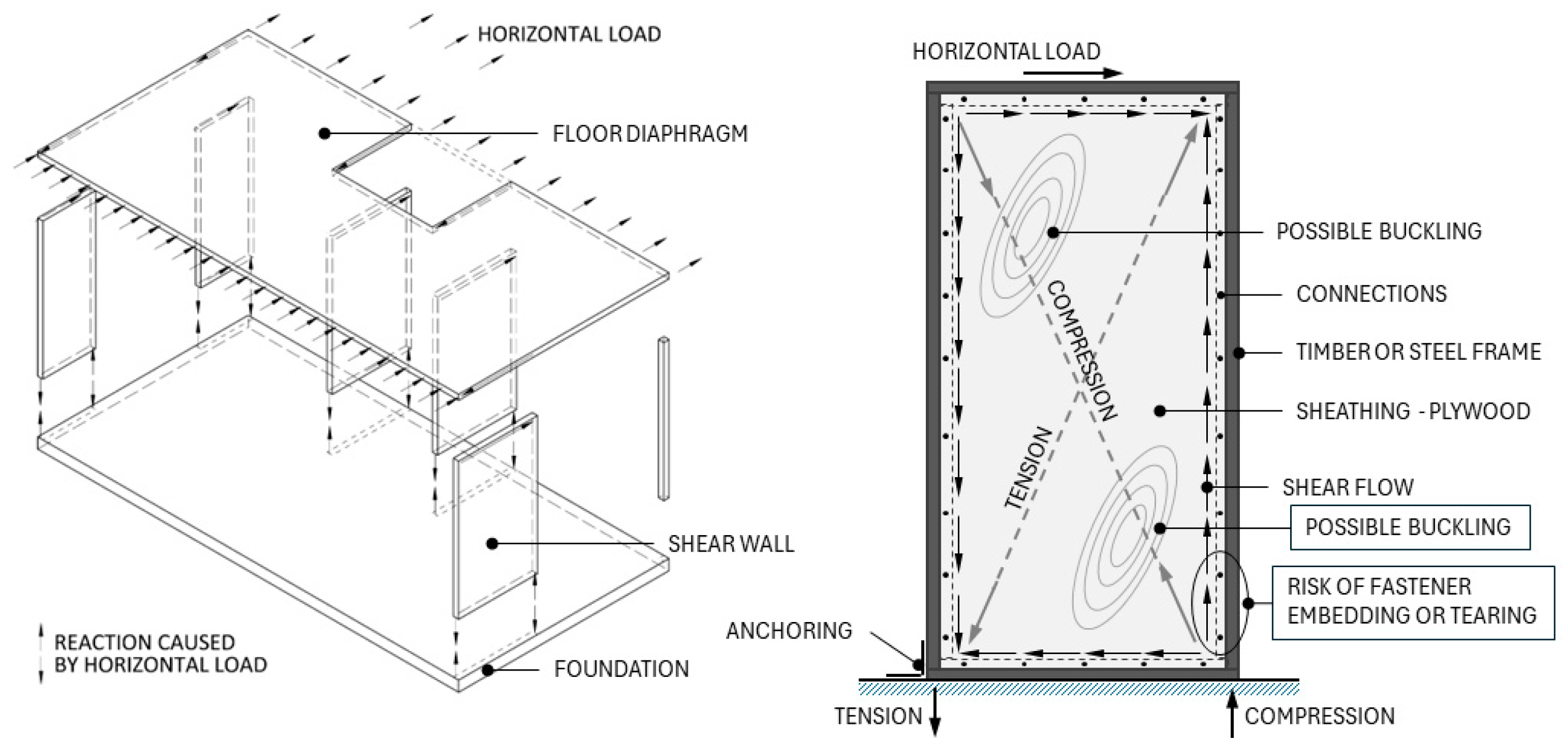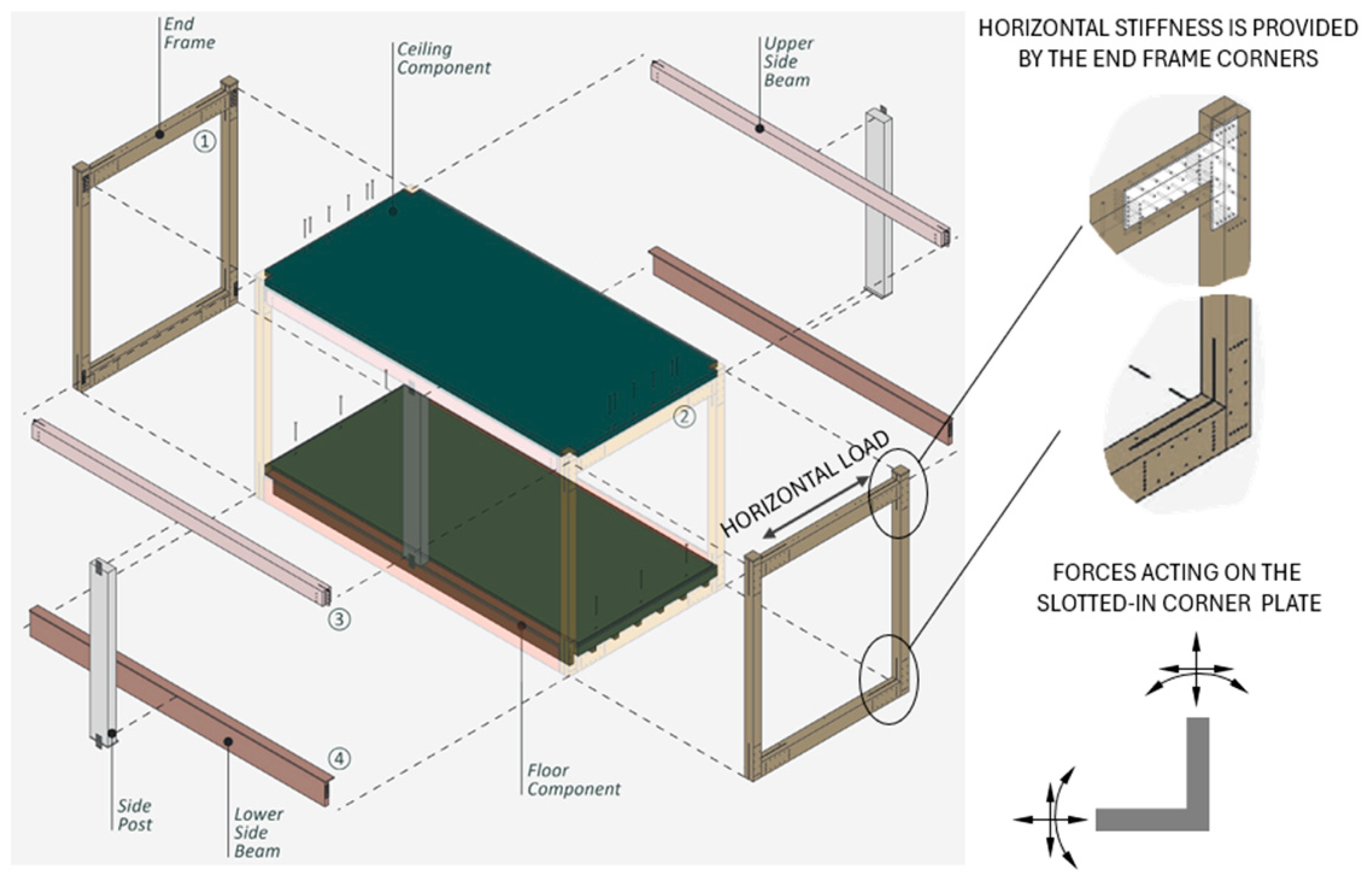Fiber-Reinforced Plywood: Increased Performance with Less Raw Material
Abstract
:1. Introduction
2. Plywood as a Construction Material
3. Fiber Reinforcement of Plywood
- Creep resistance: enhanced ability to resist deformation over time under constant loads [35];
4. Importance of Adhesives
5. Conclusions
Author Contributions
Funding
Data Availability Statement
Conflicts of Interest
References
- The Plywood Market, Latest Global Industry Size Growth Forecast, Trends Report. Available online: https://www.marketsandmarkets.com/Market-Reports/plywood-market-233250253.html?gad_source=1&gclid=CjwKCAiA-vOsBhAAEiwAIWR0TSNr-Xx8pFirkqzbKr5FnlPl3wIijoIfYa_n4ks3WYInId4dzLpp7RoCZUEQAvD_BwE (accessed on 10 May 2024).
- UPM-Kymmene Otepää AS—Estonian Timber. Available online: https://estoniantimber.ee/best-practices/upm-kymmene-otepaa-the-biofore-company/ (accessed on 14 May 2024).
- Global Forest Resources Assessment 2020; FAO: Rome, Italy, 2020; ISBN 978-92-5-132581-0.
- Ceccherini, G.; Duveiller, G.; Grassi, G.; Lemoine, G.; Avitabile, V.; Pilli, R.; Cescatti, A. Abrupt Increase in Harvested Forest Area over Europe after 2015. Nature 2020, 583, 72–77. [Google Scholar] [CrossRef]
- EUR-Lex—52019DC0640—EN—EUR-Lex. Available online: https://eur-lex.europa.eu/legal-content/EN/TXT/?uri=COM%3A2019%3A640%3AFIN (accessed on 14 May 2024).
- Costa, D.; Serra, J.; Quinteiro, P.; Dias, A.C. Life Cycle Assessment of Wood-Based Panels: A Review. J. Clean. Prod. 2024, 444, 140955. [Google Scholar] [CrossRef]
- Spaun, F.D. Reinforcement of Wood with Fiberglass. For. Prod. J. 1981, 31, 91–96. [Google Scholar]
- Lu, J.; Sun, X.; Chen, Z.; Jiang, P.; Li, L.; Wang, M. Sandwich-Structure Inspired Super-Tough and Fire-Resistant Plywood Containing Vinyl Acetate-Ethylene Based Adhesive Reinforced by Melamine Amino Trimethyl Phosphate and Sodium Lignosulfonate. Polym. Degrad. Stab. 2024, 221, 110669. [Google Scholar] [CrossRef]
- Jakimovska popovska, V.; Iliev, B. Water Resistance of Fiberglass Reinforced Plywood during Prolonged Water Exposure. In Proceedings of the 32nd International Conference on Wood Science and Technology—ICWST, Zagreb, Croatia, 7–8 December 2023; pp. 98–105. [Google Scholar]
- Omrani, P.; Abdolzadeh, H.; Roshan, F.; Ganjkhani, M. Applicational Properties of Reinforced Plywood with Nanomaterials and Kenaf Fiber. Bioresources 2023, 18, 7054–7065. [Google Scholar] [CrossRef]
- Jorda, J.; Kain, G.; Barbu, M.-C.; Köll, B.; Petutschnigg, A.; Král, P. Mechanical Properties of Cellulose and Flax Fiber Unidirectional Reinforced Plywood. Polymers 2022, 14, 843. [Google Scholar] [CrossRef]
- Jorda, J.; Kain, G.; Barbu, M.-C.; Petutschnigg, A.; Král, P. Influence of Adhesive Systems on the Mechanical and Physical Properties of Flax Fiber Reinforced Beech Plywood. Polymers 2021, 13, 3086. [Google Scholar] [CrossRef]
- Tautenhain, F.; Rinberg, R.; Kroll, L. Novel Lightweight Semi-Finished Products Made of Poplar Veneer Plywood with Basalt Fibre Reinforcement. Key Eng. Mater. 2019, 809, 645–649. [Google Scholar] [CrossRef]
- Cakiroglu, E.O.; Demir, A.; Aydin, I. Comparison of Birch and Beech Wood in Terms of Economic and Technological Properties for Plywood Manufacturing. Drv. Ind. 2019, 70, 169–174. [Google Scholar] [CrossRef]
- Wang, T.; Wang, Y.; Crocetti, R.; Wålinder, M. In-Plane Mechanical Properties of Birch Plywood. Constr. Build. Mater. 2022, 340, 127852. [Google Scholar] [CrossRef]
- Song, Y.-J.; Lee, I.-H.; Hong, S.-I. An Evaluation of Strength Performance of the Edge Connections between Cross-Laminated Timber Panels Reinforced with Glass Fiber-Reinforced Plastic. Bioresources 2019, 14, 7719–7733. [Google Scholar] [CrossRef]
- Eero, T. Slotted-In Steel Plate Connections with Dowels in Cross-Laminated Timber Shear Walls. Ph.D. Thesis, Tallinn University of Technology, Tallinn, Estonia, 2021. [Google Scholar]
- Bouldin, J.C.; Loferski, J.R.; Hindman, D.P. Inspection of I-Joists in Residential Construction. Pract. Period. Struct. Des. Constr. 2014, 19, 04014016. [Google Scholar] [CrossRef]
- Islam, M.S.; Tannert, T.; Alam, M.S.; Shahnewaz, M.; Islam, S.; Alam, S. Reinforced wood i-joists with web opening: Experimental and analytical investigations. In Proceedings of the 2016 World Conference on Timber Engineering (WCTE 2016), Vienna, Austria, 22–25 August 2016. [Google Scholar]
- Camú, C.T.; Aicher, S. A stochastic finite element model for glulam beams of hardwoods. In Proceedings of the 2018 World Conference on Timber Engineering, Seoul, Republic of Korea, 20–23 August 2018. [Google Scholar]
- Tapia, C.; Aicher, S. Holes in glulam-orientation and design of internal reinforcements. In Proceedings of the 2016 World Conference on Timber Engineering (WCTE 2016), Vienna, Austria, 22–25 August 2016. [Google Scholar]
- Frangi, A.; Zurich, E.; Palma, P.; Kobel, P.; Minor, A. Dowelled Timber Connections with Internal Members of Densified Veneer Wood and Fibre-Reinforced Polymer Dowels. In Proceedings of the 2016 World Conference on Timber Engineering (WCTE 2016), Vienna, Austria, 22–25 August 2016. [Google Scholar]
- 369 Pattern Buildings. Available online: https://patternbuildings.com/ (accessed on 10 May 2024).
- Mischler, A. Multiple Shear Steel-to-Timber Connections with Self-Drilling Dowels. In Proceedings of the IABSE Conference: Innovative Wooden Structures and Bridges, Lahti, Finnland, 29–31 August 2001; International Association for Bridge and Structural Engineering (IABSE): Zurich, Switzerland, 2001; pp. 537–542. [Google Scholar]
- Glos, P.; Henrici, D.; Horstmann, H. Versuche Mit Großflächig Geleimten Stabwerken. Holz Als Roh-Und Werkst. 1990, 48, 333–338. [Google Scholar] [CrossRef]
- Debertolis, M.; Laurinaviciute, A. Load-Bearing Wood Connections Using Birch Plywood; KTH: Stockholm, Sweden, 2022. [Google Scholar]
- Auriga, R.; Gumowska, A.; Szymanowski, K.; Wronka, A.; Robles, E.; Ocipka, P.; Kowaluk, G. Performance Properties of Plywood Composites Reinforced with Carbon Fibers. Compos. Struct. 2020, 248, 112533. [Google Scholar] [CrossRef]
- Kramár, S.; Král, P. BFRP Plywood Coating. Bioresources 2019, 14, 2062–2078. [Google Scholar]
- Lohmus, R.; Kallakas, H.; Tuhkanen, E.; Gulik, V.; Kiisk, M.; Saal, K.; Kalamees, T. The Effect of Prestressing and Temperature on Tensile Strength of Basalt Fiber-Reinforced Plywood. Materials 2021, 14, 4701. [Google Scholar] [CrossRef]
- Karri, R.; Lappalainen, R.; Tomppo, L.; Yadav, R. Bond Quality of Poplar Plywood Reinforced with Hemp Fibers and Lignin-Phenolic Adhesives. Compos. Part C Open Access 2022, 9, 100299. [Google Scholar] [CrossRef]
- Kramár, S.; Trcala, M.; Chitbanyong, K.; Král, P.; Puangsin, B. Basalt-Fiber-Reinforced Polyvinyl Acetate Resin: A Coating for Ductile Plywood Panels. Materials 2019, 13, 49. [Google Scholar] [CrossRef] [PubMed]
- Sankar, A.; Sajan, S. Manufacturing of High Strength Plywood Composites Reinforced with Copper Fibers. Mater. Today Proc. 2021, 47, 5255–5259. [Google Scholar] [CrossRef]
- Jamshaid, H.; Mishra, R.K.; Chandan, V.; Nazari, S.; Shoaib, M.; Bizet, L.; Jirku, P.; Muller, M.; Choteborsky, R. Hybrid Thermoplastic Composites from Basalt- and Kevlar-Woven Fabrics: Comparative Analysis of Mechanical and Thermomechanical Performance. Polymers 2023, 15, 1744. [Google Scholar] [CrossRef]
- Kufel, A.; Kuciel, S. Basalt/Wood Hybrid Composites Based on Polypropylene: Morphology, Processing Properties, and Mechanical and Thermal Expansion Performance. Materials 2019, 12, 2557. [Google Scholar] [CrossRef]
- Wdowiak-Postulak, A.; Gocál, J.; Bahleda, F.; Prokop, J. Load and Deformation Analysis in Experimental and Numerical Studies of Full-Size Wooden Beams Reinforced with Prestressed FRP and Steel Bars. Appl. Sci. 2023, 13, 13178. [Google Scholar] [CrossRef]
- Bal, B.C. Screw and nail holding properties of plywood panels reinforced with glass fiber fabric. Cerne 2017, 23, 11–18. [Google Scholar] [CrossRef]
- Liu, Y.; Guan, M. Selected Physical, Mechanical, and Insulation Properties of Carbon Fiber Fabric-Reinforced Composite Plywood for Carriage Floors. Eur. J. Wood Wood Prod. 2019, 77, 995–1007. [Google Scholar] [CrossRef]
- Mayer, A.K.; Mai, C. Basalt Grid Reinforcement of Wood-Based Panels. Eur. J. Wood Wood Prod. 2024, 82, 669–681. [Google Scholar] [CrossRef]
- Núñez-Decap, M.; Barra-Rodríguez, Y.; Opazo-Carlsson, C.; Moya-Rojas, B.; Vidal-Vega, M.; Opazo-Vega, A. Use of Carbon and Basalt Fibers with Adhesives to Improve Physical and Mechanical Properties of Plywood. Appl. Sci. 2022, 12, 5114. [Google Scholar] [CrossRef]
- Ramkumar, V.R.; Anand, N.; Prakash, V.; Sujatha, D.; Murali, G. Experimental Study on the Performance of Fiber-Reinforced Laminated Veneer Lumber Produced Using Melia Dubia for Structural Applications. Constr. Build. Mater. 2024, 417, 135325. [Google Scholar] [CrossRef]
- Bal, B.C.; Bektaş, İ.; Mengeloğlu, F.; Karakuş, K.; Ökkeş Demir, H. Some Technological Properties of Poplar Plywood Panels Reinforced with Glass Fiber Fabric. Constr. Build. Mater. 2015, 101, 952–957. [Google Scholar] [CrossRef]
- Popovska, V.J.; Iliev, B. Janka hardness of plywood reinforced with fiberglass prepregs. Int. J.—Wood Des. Technol. 2022, 11, 48–54. [Google Scholar]
- Ashori, A.; Ghofrani, M.; Rezvani, M.H.; Ayrilmis, N. Development and Material Properties of Reinforced Plywood Using Carbon Fiber and Waste Rubber Powder. Polym. Compos. 2018, 39, 675–680. [Google Scholar] [CrossRef]
- Mei, C.; Zhou, D. Study on Glass Fiber Reinforced Poplar Plywood Used for Concrete Form. China For. Sci. Technol. 2009, 23, 79–82. [Google Scholar]
- Moezzipour, B.; Ahmadi, M.; Moezzipour, A. Physical and Mechanical Properties of Reinforced Ply Wood with Natural Fibers. J. Indian Acad. Wood Sci. 2017, 14, 70–73. [Google Scholar] [CrossRef]
- Xu, H.; Nakao, T.; Tanaka, C.; Yoshinobu, M.; Katayama, H. Effects of Fiber Length and Orientation on Elasticity of Fiber-Reinforced Plywood. J. Wood Sci. 1998, 44, 343–347. [Google Scholar] [CrossRef]
- Yao, J.; Hu, Y.; Lu, W. Coir-Mat-Core Sandwich. Bioresources 2012, 7, 663–674. [Google Scholar] [CrossRef]
- Kumar, H.; Dutt, M. Investigational Study and Valuation of Mechanical Properties of Woven and Chopped Basalt Fibre Strengthen Composites. J. Mater. Sci. Manuf. Technol. 2019, 4, 23–37. [Google Scholar] [CrossRef]
- Muzyczek, M. The Use of Flax and Hemp for Textile Applications. In Handbook of Natural Fibres; Elsevier: Amsterdam, The Netherlands, 2020; pp. 147–167. [Google Scholar]
- Pizzi, A. Wood Products and Green Chemistry. Ann. For. Sci. 2016, 73, 185–203. [Google Scholar] [CrossRef]
- Dunky, M. Wood Adhesives Based on Natural Resources: A Critical Review Part II. Carbohydrate-Based Adhesives. Rev. Adhes. Adhes. 2020, 8, 333–378. [Google Scholar] [CrossRef]
- Dunky, M. Wood Adhesives Based on Natural Resources: A Critical Review Part I. Protein-Based Adhesives. Rev. Adhes. Adhes. 2020, 8, 199–332. [Google Scholar] [CrossRef]
- Hemmilä, V.; Adamopoulos, S.; Karlsson, O.; Kumar, A. Development of Sustainable Bio-Adhesives for Engineered Wood Panels—A Review. RSC Adv. 2017, 7, 38604–38630. [Google Scholar] [CrossRef]
- Yuan, J.; Du, G.; Yang, H.; Liu, S.; Park, S.; Liu, T.; Ran, X.; Park, B.; Gao, W.; Yang, L. Fully Bio-Based Adhesive Designed through Lignin-Cellulose Combination and Interfacial Bonding Reinforcement. Ind. Crops Prod. 2023, 204, 117279. [Google Scholar] [CrossRef]
- Yang, G.; Gong, Z.; Luo, X.; Chen, L.; Shuai, L. Bonding Wood with Uncondensed Lignins as Adhesives. Nature 2023, 621, 511–515. [Google Scholar] [CrossRef] [PubMed]




| Fiber Material | Tensile Strength | Bending Strength | Additional Comments |
|---|---|---|---|
| Basalt | +20–30% [38] | +15.7% [38] 10.4–99.5% [38] | Small addition of 10 wt.% total fibers led to a significant decrease in shrinkage and the coefficient of thermal expansion [33,34]. Strong increase in the strength-to-weight ratio [38]. Higher resistance to thermal degradation with the least amount of weight loss [33]. Basalt grids result in a higher bending strength without affecting internal bond strength [38]. Stiffness increases +9–42% [39]. |
| Carbon | +17% [27] | 37% [39] 20% [27] | The MOR increase varied between 57.6% and 102.9% [8]. |
| Glass | +20% [40] | 118% and 50% [41] | Glass fiber-reinforced plywood hardness increased by 36.4% [42]. |
| Copper | +40% [32] | An increase in modulus of rupture was observed for all plywood made with the addition of copper fibers and veneer with holes [32]. | |
| Hemp | 20% [30] | Natural hemp fiber and lignin–phenolic adhesives [11]. | |
| Kenaf | 90% [10] | Use of reinforced adhesives [10]. | |
| Flax | +19% [11] | The behavior of cellulose fabric A is comparable to the flax fiber fabric [11]. |
Disclaimer/Publisher’s Note: The statements, opinions and data contained in all publications are solely those of the individual author(s) and contributor(s) and not of MDPI and/or the editor(s). MDPI and/or the editor(s) disclaim responsibility for any injury to people or property resulting from any ideas, methods, instructions or products referred to in the content. |
© 2024 by the authors. Licensee MDPI, Basel, Switzerland. This article is an open access article distributed under the terms and conditions of the Creative Commons Attribution (CC BY) license (https://creativecommons.org/licenses/by/4.0/).
Share and Cite
Saal, K.; Kallakas, H.; Tuhkanen, E.; Just, A.; Rohumaa, A.; Kers, J.; Kalamees, T.; Lohmus, R. Fiber-Reinforced Plywood: Increased Performance with Less Raw Material. Materials 2024, 17, 3218. https://doi.org/10.3390/ma17133218
Saal K, Kallakas H, Tuhkanen E, Just A, Rohumaa A, Kers J, Kalamees T, Lohmus R. Fiber-Reinforced Plywood: Increased Performance with Less Raw Material. Materials. 2024; 17(13):3218. https://doi.org/10.3390/ma17133218
Chicago/Turabian StyleSaal, Kristjan, Heikko Kallakas, Eero Tuhkanen, Alar Just, Anti Rohumaa, Jaan Kers, Targo Kalamees, and Rynno Lohmus. 2024. "Fiber-Reinforced Plywood: Increased Performance with Less Raw Material" Materials 17, no. 13: 3218. https://doi.org/10.3390/ma17133218
APA StyleSaal, K., Kallakas, H., Tuhkanen, E., Just, A., Rohumaa, A., Kers, J., Kalamees, T., & Lohmus, R. (2024). Fiber-Reinforced Plywood: Increased Performance with Less Raw Material. Materials, 17(13), 3218. https://doi.org/10.3390/ma17133218








